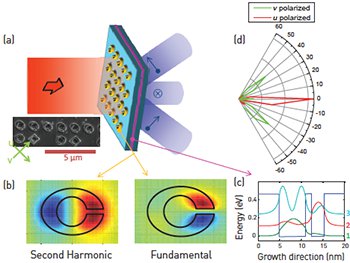 Phased-array polarized, beam-split source. (a) Schematic of the device in operation, with scanning electron micrograph of a unit cell (inset). (b) Each resonator supports two resonances matching the ISTs (c) in the semiconductor heterostructure. (d) Experimental far-field measurement of the device output.
Phased-array polarized, beam-split source. (a) Schematic of the device in operation, with scanning electron micrograph of a unit cell (inset). (b) Each resonator supports two resonances matching the ISTs (c) in the semiconductor heterostructure. (d) Experimental far-field measurement of the device output.
Phased antenna arrays are ensembles of subwavelength sources, radiating with a controllable phase relationship among them. Widely used in the microwave region of the spectrum, they enable manipulation of the direction, shape and polarization of the radiated beams. At optical frequencies, obtaining phase-locked emitters feeding each antenna and non-degenerate with an optical pump has not been possible to date.
We recently proposed a new concept for phased-array sources at infrared (IR) wavelengths.1 Strong coupling between metamaterial resonators and intersubband transitions (ISTs) in quantum wells (QWs)2,3 has enabled efficient access to the giant nonlinearities offered by ISTs.1,4,5 Our approach is based on arrays of doubly resonant, metallic, metamaterial nanocavities that are near-field coupled to highly nonlinear ISTs. The first resonance efficiently couples the incoming fundamental radiation into the ISTs. The highly localized nonlinear polarization generated within the QWs at the second harmonic (SH) frequency acts as a phase-locked “feed” for the second resonance of the nanocavity.
In this manner, each individual cavity is in fact an independent subwavelength source of radiation at the SH frequency. Due to the special shape of the cavities, the emanating SH radiation is very dipolar in nature and thus highly polarized. We experimentally con- firm that all the radiating cavities are phase-locked, and demonstrate conversion efficiencies on the order of 0.3 percent—an impressive result, as the device is less than λ/14 thick at the fundamental wavelength of 10 μm.
To demonstrate the phased-array nature of this source, we designed a device that radiates three polarized beams: one u-polarized beam in the broadside direction, and two v-polarized beams at about 40 degrees off the normal. We accomplished this by selectively rotating individual cavities to form a 10-cavity unit cell. The top row in the cell is responsible for the broadside beam, while the bottom row radiates the two side lobes.
This static version can be used in any application requiring a small-footprint IR source with a special beam profile. In the longer term, we envision that tuning the nonlinearity by electrically biasing the QWs will allow real-time control over the output beam characteristics. Furthermore, this design can be implemented at shorter wavelengths by employing a different semiconductor material, such as III-Nitride heterostructures.5
Researchers
Omri Wolf, Salvatore Campione and Igal Brener, Center for Integrated Nanotechnologies, Sandia National Laboratories, N.M., USA
John F. Klem and Michael B. Sinclair, Sandia National Laboratories, Albuquerque, N.M., USA
References
1. O. Wolf et al. Nat. Commun. 6, 7667 (2015).
2. A. Benz et al. Nat. Commun. 4, 2882 (2013).
3. S. Campione et al. Phys. Rev. B 89, 165133 (2014).
4. S. Campione et al. Appl. Phys. Lett. 104, 131104 (2014).
5. O. Wolf et. al. Appl. Phys. Lett. 107, 151108 (2015).
